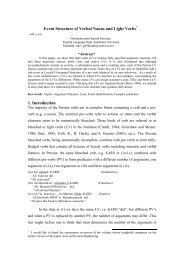Separability of Light Verb Constructions in Persian*
Separability of Light Verb Constructions in Persian*
Separability of Light Verb Constructions in Persian*
You also want an ePaper? Increase the reach of your titles
YUMPU automatically turns print PDFs into web optimized ePapers that Google loves.
illustrated <strong>in</strong> sections {3.2.1} and {3.2.2}, the predicative nouns and VNs, referr<strong>in</strong>g to<br />
actions or events, bear a-structure while non-predicative nouns, referr<strong>in</strong>g to th<strong>in</strong>gs or<br />
objects, do not bear a-structure. In addition, VN preverbs, unlike predicative and nonpredicative<br />
nouns, lack N features. In (18), we show some LVCs conta<strong>in</strong><strong>in</strong>g these three<br />
types <strong>of</strong> preverbs. The PVs <strong>in</strong> (18a) are VNs, those <strong>in</strong> (18b) are predicative nouns, and<br />
those <strong>in</strong> (18c) are non-predicative nouns.<br />
(18) a. Predicative <strong>Verb</strong>al Nouns:<br />
ʔanja:m da:dan (performance + to give) ‘to perform, to do’<br />
baya:n kardan (express<strong>in</strong>g + to do) ‘to express, to say’<br />
ʔezha:r kardan (stat<strong>in</strong>g + to do) ‘to state, to say’<br />
ʔa:xa:z kardan (beg<strong>in</strong>n<strong>in</strong>g + to do) ‘to beg<strong>in</strong>’<br />
tahye kardan (provid<strong>in</strong>g + to do) ‘to provide’<br />
b. Predicative Nouns:<br />
komak kardan (help + to do) ‘to help’<br />
gerye kardan (cry + to do) ‘to cry’<br />
lotf kardan (favor + to do) ‘to do sb a favor’<br />
latme zadan (damage + to beat) ‘to damage’<br />
ra:hnema:ʔi kardan (advice + to do) ‘to advise’<br />
daʔvat Kardan (<strong>in</strong>vitation + to do) 'to <strong>in</strong>vite'<br />
c. Non-predicative Nouns:<br />
gush kardan (ear + to do) ‘to listen’<br />
ʔarre kardan (saw + to do) ‘to saw’<br />
mash<strong>in</strong> kardan (mach<strong>in</strong>e + to do) ‘to mach<strong>in</strong>e’<br />
ʔatash zadan (fire + to beat) ‘to fire, to set to fire’<br />
q<strong>of</strong>l kardan (lock + to do) ‘to lock’<br />
Karimi-Doostan (2008a: 189-192), based on semantic and morphosyntactic grounds,<br />
claims that predicative VNs (18a) are different from nouns and they cannot be classified<br />
as any <strong>of</strong> the Persian lexical categories, i.e. V, N, P or Adj/Adv. In the rest <strong>of</strong> this<br />
section, different types <strong>of</strong> nom<strong>in</strong>al preverbs are focused on.<br />
3.2.1. Predication and Nom<strong>in</strong>al Preverbs<br />
The PVs may either refer to th<strong>in</strong>gs or objects <strong>in</strong> the universe (18c) or to actions<br />
and events (18a-b). Consequently, the nom<strong>in</strong>al PVs are <strong>of</strong> two types, non-predicative and<br />
13



